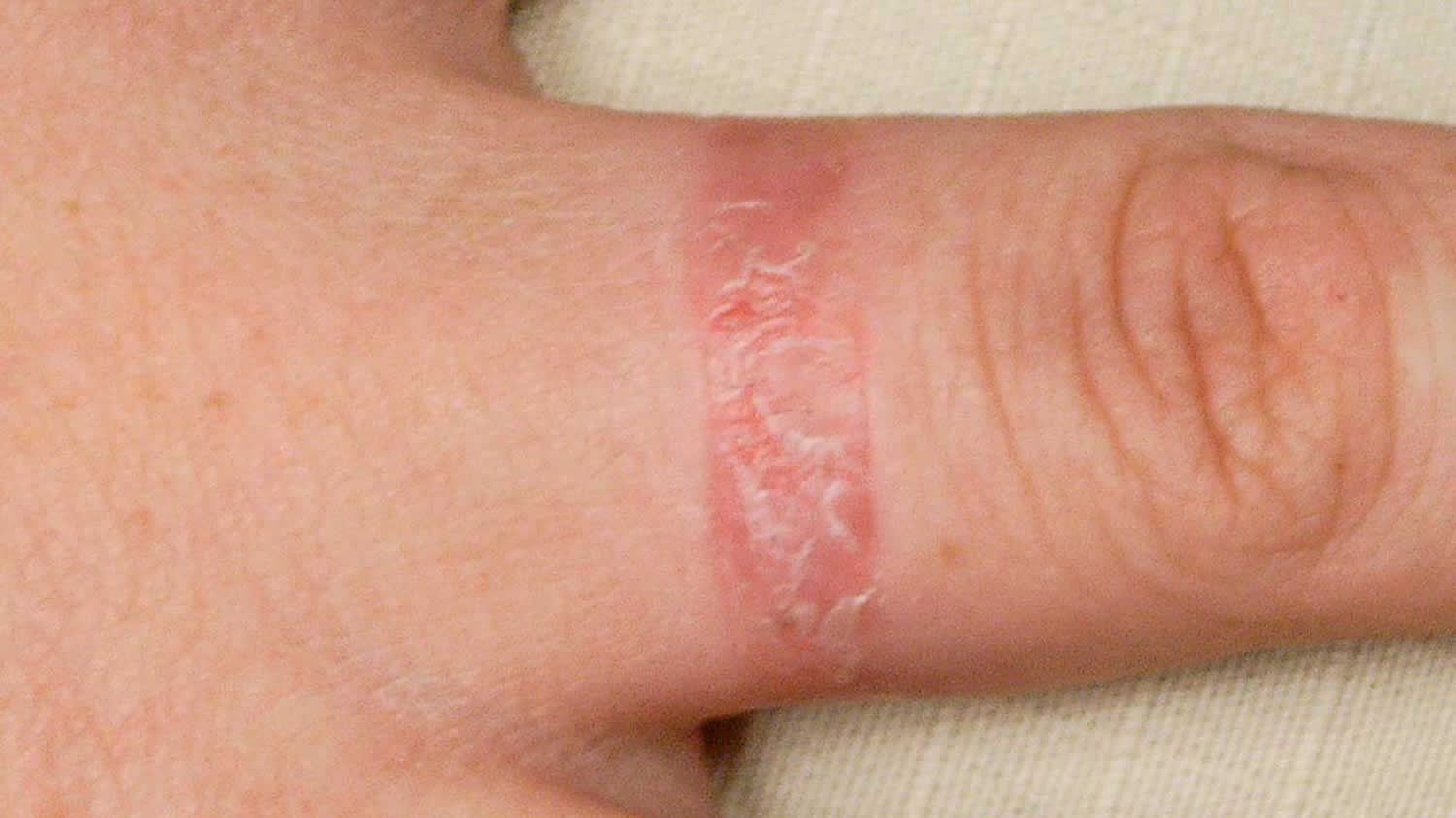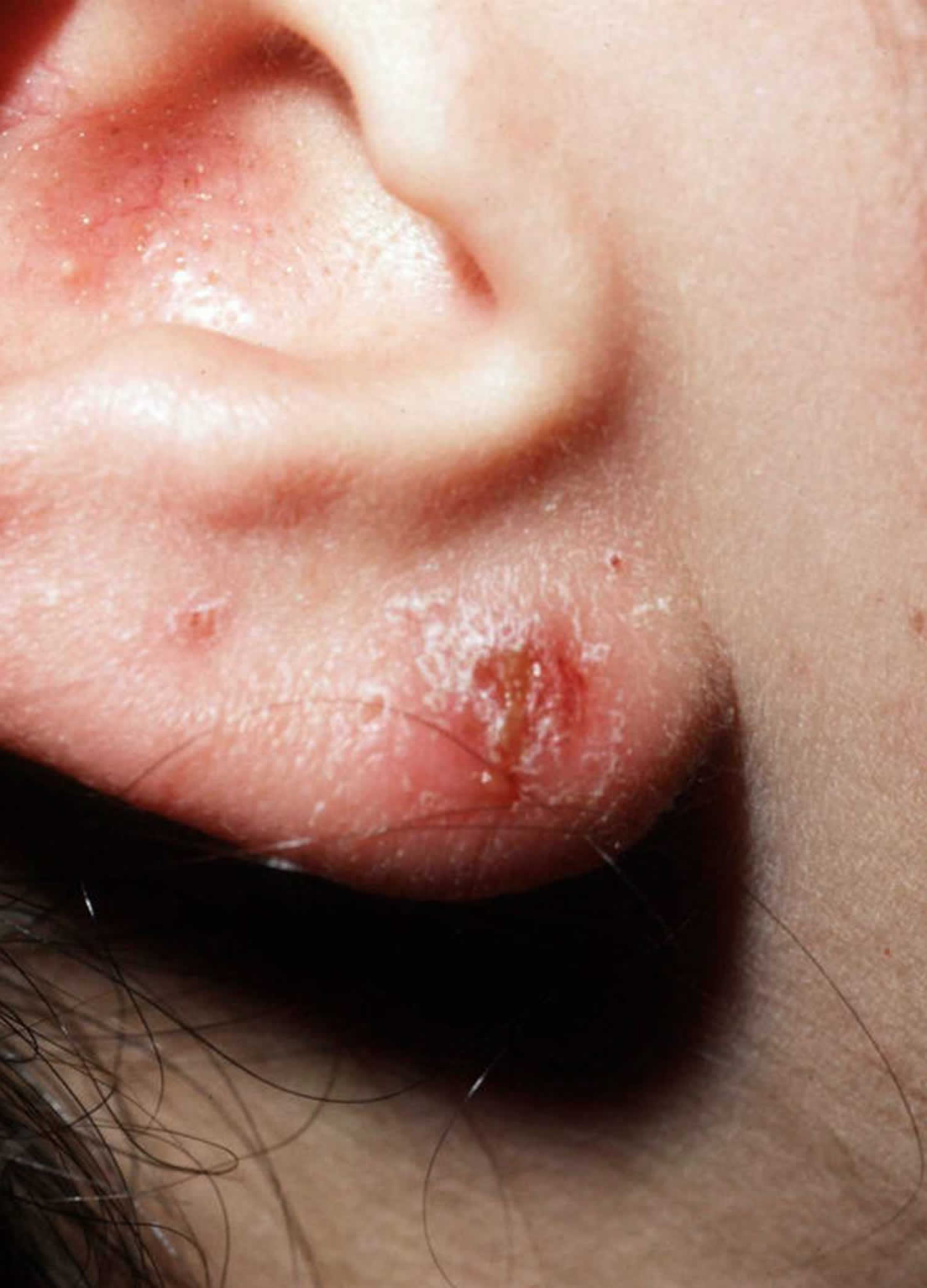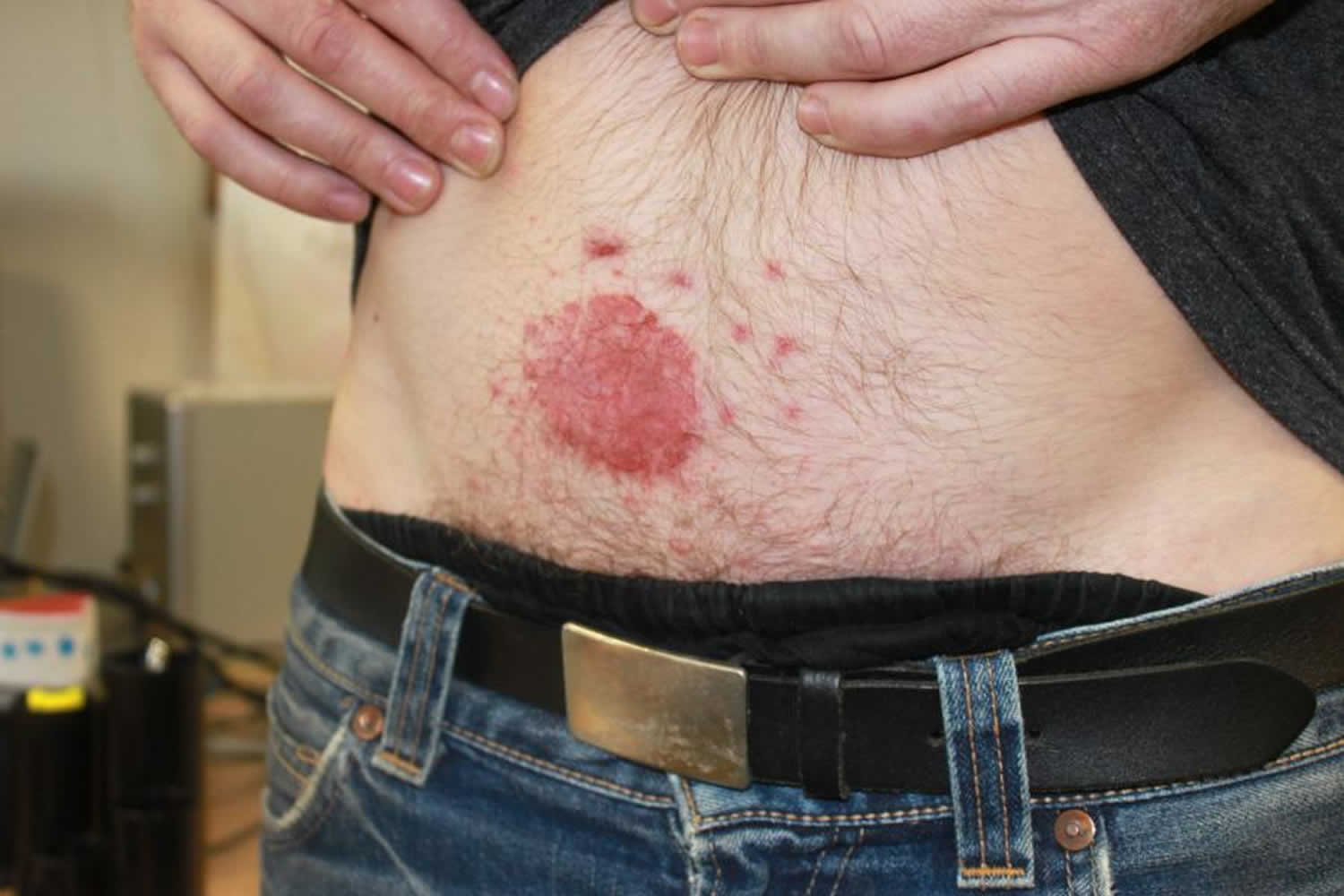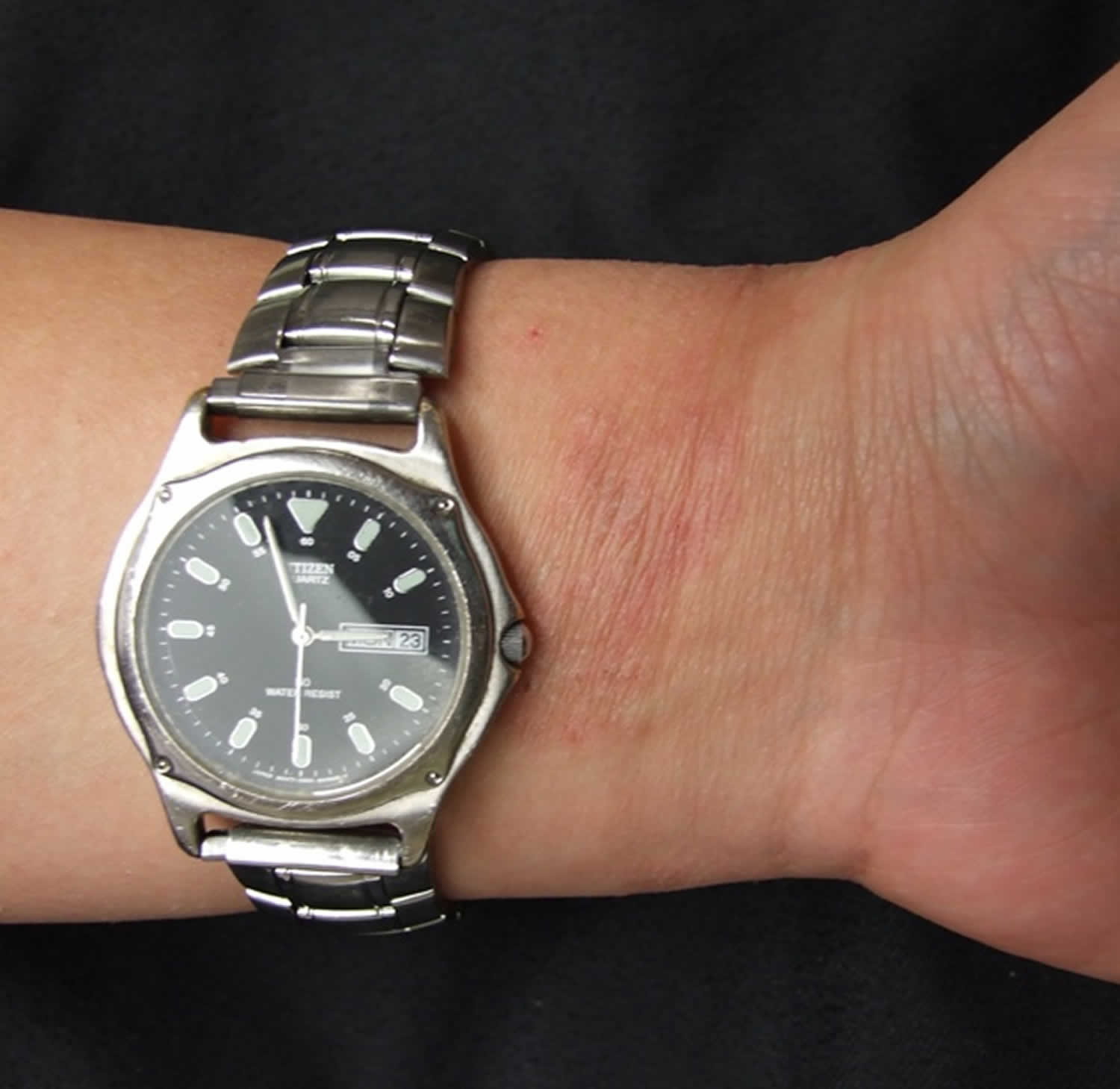Nickel allergic contact dermatitis
Nickel allergy is one of the most common causes of contact allergic dermatitis, which is an itchy rash that appears where your skin touches a usually harmless substance. In affected individuals, dermatitis (also called eczema) develops in places where nickel-containing metal is touching your skin. The most common sites for nickel dermatitis are the earlobes (from earrings), the wrists (from a watch strap) and the lower abdomen (from a jeans stud or belt buckle); the affected areas become intensely itchy and may become red and blistered (acute dermatitis) or dry, thickened and pigmented (chronic dermatitis).
Nickel allergic contact dermatitis may develop at any age and in males and females 1. Nickel allergy is more common in women, probably because they are more likely to have piercings than men, although this is changing 2. It may take repeated or prolonged exposure to items containing nickel to develop a nickel allergy. Once you develop a nickel allergy, however, you’ll always be sensitive to the metal for many years, often life-long and you need to avoid contact. Furthermore, the degree of nickel allergy varies. Some people develop nickel dermatitis from even brief contact with nickel-containing items, while others break out only after many years of skin contact with nickel.
In individuals who are sensitive to nickel, ingestions of certain foods (e.g., chocolate, nuts, oats, green beans, peas) may cause systemic nickel allergy syndrome or lead to chronic dermatitis 3. Implantable devices also lead to an increased risk of a systemic reaction 4. It is believed certain underlying inflammatory conditions (e.g., ulcerative colitis) can increase the likelihood of developing a nickel allergy 5.
Treatment is often necessary for nickel dermatitis and can reduce the symptoms of nickel allergy.
- Compresses Dry up blisters with diluted vinegar compresses. Do not use these if the skin is dry.
- Topical steroids Apply topical steroid to the dermatitis as directed by your doctor.
- Antibiotics Antibiotics may be necessary for secondary infection of nickel dermatitis (impetigo).
- Emollients Apply soothing emollient creams frequently to relieve itch and dry skin.
Unfortunately, desensitization with injections or pills is not possible so the nickel allergy tends to persist long-term. It is essential to avoid skin contact with nickel-containing metals.
Figure 1. Rash from nickel allergy (nickel in earrings)
Figure 2. Belt buckle nickel dermatitis
Figure 3. Nickel allergic contact dermatitis (from a watch winder)
If you have a skin rash and don’t know how you got it, talk to your doctor. If you’ve already been diagnosed with nickel allergy and are sure you’re reacting to nickel exposure, use the over-the-counter treatments and home remedies your doctor has previously recommended.
However, if these treatments don’t help, see your doctor. If you think the area may have become infected, see your doctor right away. Signs and symptoms that might indicate an infection include:
- Increased redness
- Warmth
- Pus in the affected area
- Pain
Can nickel allergy affect areas that are not in contact with metal?
This has been debated by dermatologists. Some people develop intermittent or persistent eczema on their hands and feet. It is usually a blistering type of eczema, known as pompholyx or dyshidrotic hand dermatitis. Sometimes it is due to contact with metal items containing nickel, but often there is no obvious reason for it.
It has been suggested that in nickel allergic people pompholyx may be due to nickel in the diet. Unfortunately it is not possible to avoid ingesting nickel as it is present in most foodstuffs. A low-nickel diet is only rarely helpful.
Nickel allergic contact dermatitis cause
The exact cause of nickel allergy is unknown. As with other allergies, nickel allergy develops when your immune system views nickel as a harmful, rather than harmless substance. Normally, your immune system only reacts to protect your body against bacteria, viruses or toxic substances.
Once your body has developed a reaction to a particular agent (allergen) — in this case, nickel — your immune system will always be sensitive to it. That means anytime you come into contact with nickel, your immune system will respond and produce an allergic response.
Your immune system’s sensitivity to nickel may develop after your first exposure or after repeated or prolonged exposure. Sensitivity to nickel may, in part, be inherited.
Sources of nickel exposure
Common items that may expose you to nickel include:
- Jewelry for body piercings
- Other jewelry, including rings, bracelets, necklaces and jewelry clasps
- Watchbands
- Clothing fasteners, such as zippers, snaps and bra hooks
- Belt buckles
- Eyeglass frames
- Coins
- Metal tools
- Cellphones
- Keys
- Military “dog-tag” ID
- Chalk
- Medical devices
- Laptops or computer tablets
- E-cigarettes
Risk factors for developing nickel allergy
Certain factors may increase your risk of developing a nickel allergy, including:
- Having ear or body piercings. Because nickel is common in jewelry, nickel allergy is most often associated with earrings and other body-piercing jewelry containing nickel.
- Working with metal. If you work in an occupation that constantly exposes you to nickel, your risk of developing an allergy may be higher than it is for someone who doesn’t work with the metal. In addition, people who have regular exposure to nickel while doing “wet work” — as a result of either sweat or frequent contact with water — may be more likely to develop nickel allergy. These people may include bartenders, people who work in certain food industries and domestic cleaners. Other people who may have an increased risk of nickel allergy include metalworkers, tailors and hairdressers.
- Being female. Females are more likely to have a nickel allergy than are males. This may be because females tend to have more piercings. A recent study found that overweight women seem to have an even higher risk of nickel allergy.
- Having a family history of nickel allergy. You may have inherited a tendency to develop a nickel allergy if other people in your family are sensitive to nickel.
- Being allergic to other metals. People who have a sensitivity to other metals may also be allergic to nickel.
Nickel allergic contact dermatitis pathophysiology
Allergic contact dermatitis represents the classic presentation of a T cell-mediated, delayed-type hypersensitivity response to exogenous agents. The initial step in the development of allergic contact dermatitis, as in nickel allergy, is hapten binding to a skin carrier protein. A hapten by itself is not immunogenic but becomes so after binding to a skin protein carrier. The hapten protein complex forms through covalent bonds between the hapten and amino acid side chains of target proteins within the skin.[8] The complex ultimately produces the sensitization of T cells. Sensitized T cells encountering the antigen at any time later will then lead to the release of cytokines, which in turn leads to macrophage activation and produces the immune response 6. In summary, the sensitization process requires an initial exposure to allow the immune system to recognize the antigen later and lead to the immune response that causes nickel allergic contact dermatitis.
Nickel allergic contact dermatitis prevention
The best strategy to prevent a nickel allergy from developing is to avoid prolonged exposure to items containing nickel. If you already have a nickel allergy, the best way to prevent an allergic reaction is to avoid contact with the metal.
However, it’s not always easy to avoid nickel because it’s present in so many products. Home test kits are available to check for nickel in metal items.
The following tips may help you avoid nickel exposure:
Test your metal items
A nickel-testing kit can obtained from your dermatologist, pharmacist or online supplier. The 2-bottle or single solution formula contain 1% dimethylglyoxime and 10% ammonium hydroxide.
Apply a drop from each bottle (or from the single one) on to the metal item to be tested – first try it on a coin. Use a cotton bud to rub gently – observe the color on the bud. If it remains clear, the item has no free nickel and will not cause dermatitis. If the cotton bud has stained pink, the item contains nickel and may cause dermatitis if it touches the skin of someone allergic to nickel. The chemicals will not harm jewellery.
Wear hypoallergenic jewelry
Avoid jewelry that contains nickel. Jewellery such as necklaces, necklace-clips, earrings, bracelets, watch-straps and rings, may contain nickel. Purchase jewelry that’s made of materials that aren’t likely to cause allergic reactions. “Hypoallergenic” stainless steel (nickel-free stainless steel or surgical-grade stainless steel), solid gold (12 carat or more), nickel-free yellow gold and sterling silver jewellery should be safe. Nine-carat gold and white gold contain nickel. Plastic covers for earring studs can be obtained. Coating the stud with nail varnish is not recommended as the varnish soon chips off.
Surgical-grade stainless steel may contain some nickel, but it’s generally considered hypoallergenic for most people. Be sure that your earring backings also are made of hypoallergenic materials.
Use substitute materials
Look for safer substitutes for common nickel-containing items:
- Watchbands made of leather, cloth or plastic
- Zippers or clothing fasteners made of plastic or coated metals
- Plastic or titanium eyeglass frames
Choose a piercing studio carefully
Check with your state or local health department to find out what rules apply to your area and be certain to choose a studio that follows these rules. Visit a studio before getting a piercing to make sure that the piercer provides a clean, professional environment.
Also, check to be sure the studio uses sterile, nickel-free or surgical-grade stainless steel needles in sealed packages. If the studio uses a piercing gun, check to see if the part that touches the person getting pierced isn’t used on other customers. Check that the studio only sells hypoallergenic jewelry and can provide documentation of metal content of the products for sale.
Nickel in clothing
Metal zips, bra hooks, suspender clips, hair-pins, buttons, studs, spectacle frames etc. are likely to contain nickel. Use substitutes made of plastic, coated or painted metal or some other material.
Nickel in personal articles
Personal items with nickel that may touch the skin causing dermatitis include mobile phones, lipstick holders, powder compacts, handbag catches, cigarette lighters, razors, keys, key rings, knives, and pens. These may sometimes cause dermatitis when they are within a pocket.
Metal items in the home
Cupboard handles, kitchen utensils, cutlery, toaster, metal teapots, scissors, needles, pins, thimble, vacuum cleaners, torches, bath plugs and many other items may contain nickel. Choose tools with plastic handles.
Stainless steel does not usually cause dermatitis unless it is nickel-plated.
Money
Silver-colored coins are composed of cupro-nickel. Cashiers with nickel allergy may develop hand dermatitis from this source. Wear gloves to handle money or pay with a credit card or cheque.
Metal at work
Nickel dermatitis may be aggravated by contact with paper clips, typewriter keys, instruments, metal fragments from a lathe or chain saw.
Create a barrier
If you have to be exposed to nickel at work, creating a barrier between you and the nickel may help. If your hands have to touch nickel, wearing gloves may help.
Try covering buttons, snaps, zippers or tool handles with duct tape or with a clear barrier, such as Nickel Guard. Clear nail polish on jewelry may help, but may have to be reapplied often.
Low nickel diet
This diet low in nickel-containing foods has been suggested to patients with severe contact allergy to nickel. Its efficacy is unknown. Nickel cannot be completely avoided from diet. Avoid nickel-plated utensils and metal cooking pots. Avoid drinking the initial flow of water from a metal tap.
Foods allowed:
- Meat, poultry, most fish, eggs, milk, yogurt, cheese, quark, butter, margarine
- Cereals, bread, flour, rice, pasta
- Small servings of wholemeal flour, wholegrain cereals, wheat bran and wheatgerm
- Most vegetables
- Small servings of beetroot, cabbage, cauliflower, leeks , parsnips, potatoes, spinach
- Fruit such as bananas, and occasional apples and citrus fruit, raw and stewed
- Tea, coffee, soft drinks, cordials
Foods to avoid:
- Canned food, especially spaghetti and baked beans
- Green beans, soya beens, broccoli, peas including split peas, canned vegetables
- Canned fruit, dried fruit, nuts, oatmeal
- Cocoa, drinking chocolate, chocolate
Nickel allergic contact dermatitis signs and symptoms
Nickel allergy contact dermatitis usually begins within hours to days after exposure to nickel. The reaction may last as long as two to four weeks. The reaction tends to occur only where your skin came into contact with nickel, but sometimes may appear in other places on your body.
Nickel allergy signs and symptoms include:
- Rash or bumps on the skin
- Itching, which may be severe
- Redness or changes in skin color
- Dry patches of skin that may resemble a burn
- Blisters and draining fluid in severe cases.
Nickel allergic contact dermatitis complications
A nickel allergy rarely causes significant complications unless the offending agent is left to irritate the patient continually or if the patient develops openings in the skin. The skin may become excoriated and broken, leading to an increased risk of infection. The skin breaks and infections can lead to the development of a superimposed infection (cellulitis). Cellulitis can complicate the treatment plan for the patient, and topical corticosteroids may limit the patient’s local immune response to fight the cellulitis. Treatment of the skin infection must be completed along with the removal of the offending agent to allow the skin to heal properly.
Nickel allergic contact dermatitis diagnosis
Your doctor can usually diagnose nickel allergy based on your skin’s appearance, and a recent exposure to items that may contain nickel. Nickel allergy is diagnosed by the clinical history and by special allergy tests, patch tests.
If the cause of your rash isn’t apparent, however, your doctor may recommend a patch test (contact hypersensitivity allergy test). He or she may refer you to an allergy specialist (allergist) or a skin specialist (dermatologist) for this test. Patients undergoing baseline series patch tests are specifically tested to nickel sulphate-hexahydrate. The chemical formula for this is NiO4S6H2O.
Patch testing
During a patch test, very small quantities of potential allergens (including nickel) are applied to your skin and covered with small patches. The patches remain on your skin for two days before the doctor removes them. If you have a nickel allergy, the skin under the nickel patch will be inflamed when the patch is removed or in the days after removal of the patch.
Because of the low concentrations of allergens used, patch tests are safe even for people with severe allergies.
Nickel allergic contact dermatitis treatment
There’s no cure for nickel allergy. Once you develop a sensitivity to nickel, you’ll develop a rash (contact dermatitis) whenever you come into contact with the metal.
Medications
Your doctor may prescribe one of the following medications to reduce irritation and improve the condition of a rash from a nickel allergy reaction:
- Corticosteroid cream, such as clobetasol (Clobex, Cormax, others) and betamethasone dipropionate (Diprolene). Long-term use of these can lead to skin thinning.
- Nonsteroidal creams, such as pimecrolimus (Elidel) and tacrolimus (Protopic). The most common side effect is temporary stinging at the application site.
- Oral corticosteroid, such as prednisone, if the reaction is severe or a rash covers a large area. These drugs can cause a host of side effects, including weight gain, mood swings and increased blood pressure.
- Oral antihistamine, such as fexofenadine (Allegra) and cetirizine (Zyrtec), for relief of itching. However, these may not be very effective for skin itching.
Phototherapy
This treatment involves exposing your skin to controlled amounts of artificial ultraviolet light. It’s generally reserved for people who haven’t gotten better with topical or oral steroids. It can take months for phototherapy to have an effect on a nickel allergy reaction.
Home remedies
You may use some of the following treatments at home to treat contact dermatitis due to nickel allergy. If these treatments don’t help or the rash worsens, contact your doctor. Home remedies include the following:
- Use soothing lotions, such as calamine lotion, which may ease itching.
- Moisturize regularly. Your skin has a natural barrier that’s disrupted when it reacts to nickel and other allergens. Using emollient creams or lotions, such as petroleum jelly or mineral oil, could reduce your need for topical corticosteroids.
- Apply wet compresses, which can help dry blisters and relieve itching. Soak a clean cloth in tap water or Burow’s solution, an over-the-counter medication containing aluminum acetate.
Avoid certain over-the-counter ointments, such as antibiotic creams, which may contain ingredients — particularly neomycin — that can worsen an allergic reaction.
Nickel allergic contact dermatitis prognosis
The overall prognosis for nickel allergy is excellent 7.
- Lagrelius M, Wahlgren CF, Matura M, Kull I, Lidén C. High prevalence of contact allergy in adolescence: results from the population-based BAMSE birth cohort. Contact Dermatitis. 2016 Jan;74(1):44-51. doi: 10.1111/cod.12492[↩]
- Dotterud LK, Smith-Sivertsen T. Allergic contact sensitization in the general adult population: a population-based study from Northern Norway. Contact Derm 2007; 56: 10–15. doi:10.1111/j.1600-0536.2007.00980.x[↩]
- Guerra L, Rogkakou A, Massacane P, Gamalero C, Compalati E, Zanella C, Scordamaglia A, Canonica WG, Passalacqua G. Role of contact sensitization in chronic urticaria. J Am Acad Dermatol. 2007 Jan;56(1):88-90.[↩]
- Schalock PC, Thyssen JP. Patch testers’ opinions regarding diagnostic criteria for metal hypersensitivity reactions to metallic implants. Dermatitis. 2013 Jul-Aug;24(4):183-5.[↩]
- Kageyama Y, Shimokawa Y, Kawauchi K, Morimoto M, Aida K, Akiyama T, Nakamura T. Higher Prevalence of Nickel and Palladium Hypersensitivity in Patients with Ulcerative Colitis. Int Arch Allergy Immunol. 2020;181(6):456-461. doi: 10.1159/000506633[↩]
- Divkovic M, Pease CK, Gerberick GF, Basketter DA. Hapten-protein binding: from theory to practical application in the in vitro prediction of skin sensitization. Contact Dermatitis. 2005 Oct;53(4):189-200.[↩]
- Rishor-Olney CR, Gnugnoli DM. Nickel Allergy. [Updated 2020 May 9]. In: StatPearls [Internet]. Treasure Island (FL): StatPearls Publishing; 2020 Jan-. Available from: https://www.ncbi.nlm.nih.gov/books/NBK557638[↩]








